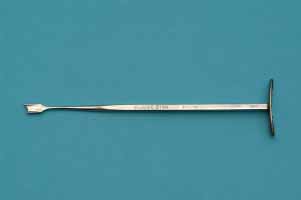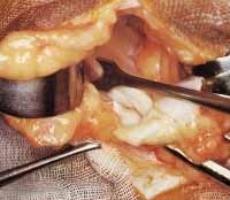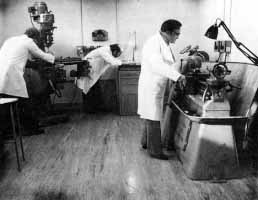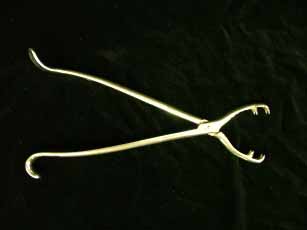Early Surgical Specialities
Orthopaedic Surgery
Previously within the realm of general surgery, Orthopaedics developed as a specialised area in the first half of the 20th century.
One of the first orthopaedic surgeons in Scotland was Ian Smillie (1907-1992), who on the outbreak of World War Two had become Surgeon in Charge of the Emergency Medical Service Hospital at Larbert.
Here he developed specialist teams for the care of patients, including nurses, orthotists and physiotherapists. In recognition of his wartime service he was made an OBE.

Ian Smillie (Courtesy of the Journal of Bone and Joint Surgery)

Smillie's classic textbook 'Injuries of the Knee Joint' (1946) (Tayside Medical History Museum)
When the NHS was formed in 1948, Smillie was appointed Surgeon in charge of the Orthopaedic Service for Eastern Scotland. He was initially based at Bridge of Earn Hospital, where he further developed his team concept and his ideas on early mobilisation and intensive rehabilitation. Later, he also established orthopaedic clinics in Dundee, not entirely with the approval of some of the general surgeons. In 1967 he became the first holder of the Chair of Orthopaedic Surgery at the University of St Andrews.
Smillie became a world authority on the surgery of the knee and enjoyed a reputation as a brilliant technical surgeon and surgical innovator. The meniscectomy knives which he designed came to be used throughout the world, and his monographs on Injuries of the Knee Joint and Diseases of the Knee Joint became international classics, leading to invitations to teach in many parts of the world.
On one occasion an arch rival attacked Smillie's meniscectomy knives, saying "The only use for which I can recommend Mr Smillie's knives is to sharpen pencils". The audience was astonished when Smillie rose to say "I have to agree with Mr X," but after a long pause he added: "The best possible use Mr X can make of these knives is to sharpen pencils." His many interests included racing exotic cars at Brooklands in the 1930s and writing A Guide to the Stalking of Red Deer in Scotland.


Menisectomy knife designed by Prof Smillie (DUNUC 8199) and illustration from Smillie's Colour
Atlas of Menisectomy (1983) showing his knives in use (Tayside Medical History Museum)

George Murdoch (Courtesy of NHS Tayside)
Smillie's successor was Prof George Murdoch (1921-2004), who had also worked at Larbert during the war, and went on to build his reputation through specialising in the study of prosthetics and orthotics. He founded and developed the Dundee Limb Fitting Centre in Broughty Ferry, opened in 1965 by the legendary amputee air ace Douglas Bader.
The subsequent development of Tayside Rehabilitation Engineering Services at the Limb Fitting Centre (which moved to TORT at Ninewells in 1999) have led to international recognition for the treatment of the amputee and assessment of gait analysis. In 2007, Professor Smillie was posthumously awarded the American Orthopaedic Society for Sports Medicine's highest honour.


The Dundee Limb Fitting Centre in Broughty Ferry (Courtesy of Tayside Orthopaedic & Rehabilitation
Technology Centre) and interior view showing the making of artificial limbs, 1982 (Courtesy of NHS Tayside)


Bone-holding forceps (DUNUC 4377/5) and Hey Groves bone clamps (DUNUC 8100)